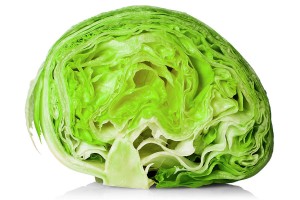Is iceberg lettuce a food worthy only for rabbits? Not anymore, according to a recent study published by the Centers of Disease Control and Prevention (CDC). Iceberg lettuce, a vegetable once thought to have little nutritional value, is now rocking the boat of nutrition and climbing up the chart of nutrient-dense fruits and vegetables.
In the study, researchers aimed to find out which powerhouse fruits and vegetables (PFV) could reduce the risk of chronic disease. While these foods lack a concrete definition, they can generally be described as “green leafy, yellow/orange, citrus, and cruciferous items.” According to the researchers, PFV are foods “providing, on average, 10% or more daily value per 100 kcal of 17 qualifying nutrients.” The nutrients analyzed for each food included potassium, fiber, protein, calcium, iron, thiamin, riboflavin, niacin, folate, zinc, and vitamins A, B6, B12, C, D, E, and K, which are considered to be important for public health by the Food and Agriculture Organization of the United Nations and Institute of Medicine.
To identify potential PFV, researchers consulted scientific literature and consumer guidelines. Since cooking foods can alter their nutrient contents, researchers collected data from only raw foods. After identifying potential PFV, researchers calculated the nutrient density of each item and classified items that provided 10 percent or more daily value of a nutrient as PFV.
Some of the most nutrient-dense foods included cruciferous items (watercress, Chinese cabbage, collard green, kale, and arugula) and green leafy items (chard, beet green, spinach, chicory, and leaf lettuce); in contrast, items that belonged in the yellow/orange (carrot, tomato, winter squash, and sweet potato), citrus (lemon, orange, lime, and grapefruit), and berry (strawberry and blackberry) groups ranked lower on the list of nutrient-rich foods. Here’s another kicker: of the 41 items on the nutrient-dense food chart, only seven are fruits.
Surprisingly, iceberg lettuce ranked higher in nutritional value than 18 other fruits and vegetables that are commonly believed to be healthier, such as sweet potatoes, oranges, blackberries, and strawberries. On a nutrient-density scale of 1 to 100 (100 being the most dense), iceberg lettuce scored 18, trailing close behind broccoli at 34.9 and kale at 49. As it turns out, iceberg lettuce is an excellent source of vitamin K, which prevents osteoporosis and heart disease, as well as vitamin A, which is essential for good vision and healthy skin. So make some room for iceberg lettuce in your diet by adding it to a salad or on a sandwich. The wedge is your friend.

